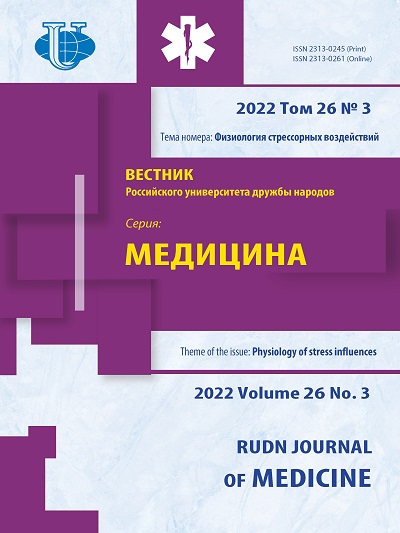Microenvironment influence on the development of epithelial-mesenchymal transformation in lung cancer
- Authors: Kondratyuk R.B.1, Grekov I.S.1, Seleznev E.A.2
-
Affiliations:
- M. Gorky Donetsk national medical University
- Amvrosievsky Central District Hospital
- Issue: Vol 26, No 3 (2022): PHYSIOLOGY OF STRESS INFLUENCES
- Pages: 325-337
- Section: ANATOMY. PATHOLOGICAL ANATOMY
- URL: https://journals.rudn.ru/medicine/article/view/32234
- DOI: https://doi.org/10.22363/2313-0245-2022-26-3-325-337
- ID: 32234
Cite item
Full Text
Abstract
Relevance. Epithelial-mesenchymal transformation (EMT) largely determines the biological behavior and prognosis of cancers of various localizations. It is known that the determining role in the control and implementation of the transition of the epithelial phenotype to the mesenchymal belongs to the microenvironment. At the same time, the histochemical and microscopic characteristics of stromal elements remain unclear; therefore, the aim of our study was to establish the morphological features of the stroma that affect the development of EMT in lung cancer. Materials and Methods. We studied 32 cases of lung cancer with hematoxylin and eosin staining of sections, Alcian blue at pH 1.0 and 2.5, PAS reaction, as well as immunohistochemical studies with monoclonal antibodies to HMW, AE 1 / AE 3, cytokeratin 18, c-erb B 2, vimentin E-cadherin, alpha-smooth muscle actin, GFAP and chromogranin A, Ki-67. In 16 cases, there was widespread epithelial-mesenchymal transformation (EMT), in 14 cases - focal and in 2 cases EMT was absent. In half of the cases of widespread EMT, it was complete; among the cases of focal EMT, it was not complete. The transition from the epithelial to the mesenchymal phenotype was facilitated by the activation of the stroma, namely, the presence of myofibroblasts and alcianophilia of the extracellular matrix, inflammatory cell infiltration, expression of the epidermal growth factor receptor (c-erb B 2) in stromal cells, proliferation and neurogenic differentiation of stromal cells of stromal cells. Results and Discussion. The activated stroma correlates with the frequency of EMT. Thus, large areas of activated stroma with the presence of myofibroblasts and alcianophilia of the extracellular matrix are more common in cases of widespread EMT (14 out of 16-87.5 %) than in cases of focal EMT (4 out of 14-28.6 %). The differences are statistically significant, p < 0.01. Inflammatory cell infiltration, which is the source of a signal for transformation, expression of the epidermal growth factor receptor (c-erb B 2) in stromal cells, proliferation, and neurogenic differentiation of stromal cells also correlated with the frequency of EMT. In all cases, the differences are statistically significant, p<0.01. Conclusions. The data obtained indicate the undoubted influence of signals from the activated stroma on the development of epithelial-mesenchymal transformation of tumor cells.
About the authors
Roman B. Kondratyuk
M. Gorky Donetsk national medical University
Author for correspondence.
Email: rbkondrat@gmail.com
ORCID iD: 0000-0001-5928-8799
Donetsk, Donetsk People Republic
Ilya S. Grekov
M. Gorky Donetsk national medical University
Email: rbkondrat@gmail.com
Donetsk, Donetsk People Republic
Evgenii A. Seleznev
Amvrosievsky Central District Hospital
Email: rbkondrat@gmail.com
ORCID iD: 0000-0002-2413-8843
Amvrosievka, Donetsk People Republic
References
- Radisky DC. Epithelial-mesenchymal transition. J Cell Sci. 2005;1;118(19):325-326. doi: 10.1242/jcs.02552
- Mnihovich MV, Vernigorodskij SV, Bun’kov KV, Mishina ES. Jepitelial’no-mezenhimal’nyj perehod, transdifferenciacija, reprogrammirovanie i metaplazija: sovremennyj vzgljad na problemu. Vestnik Nacional’nogo mediko-hirurgicheskogo Centra im. N.I. Pirogova. 2018;13(2):145-152 (In Russian).
- Kondratjuk RB, Grekov IS, Jarkov A.M., Rusika A.A., Shvorob D.S. Rol’ jepitelial’no-mezenhimal’noj transformacii v rakah razlichnoj lokalizacii (Chast’ 1). Novoobrazovanie. 2021;13(2):91-95. doi: 10.26435/neoplasm.v13i2.376 (In Russian).
- Nisticò P, Bissell MJ, Radisky DC. Epithelial-mesenchymal transition: general principles and pathological relevance with special emphasis on the role of matrix metalloproteinases. Cold Spring Harb Perspect Biol. 2012;4(2):115-130. doi: 10.1101/cshperspect.a011908
- Chou MY. Interplay of Immunometabolism and Epithelial-Mesenchymal Transition in the Tumor Microenvironment. Int. J. Mol. Sci. 2021;22 (18):110-118
- Lung cancer-associated mesenchymal stem cells promote tumor metastasis and tumorigenesis by induction of epithelial-mesenchymal transition and stem-like reprogram. Aging (Albany NY). 2021;13(7):9780-9800
- Vasilenko IV, Kondratyk RB, Grekov IS, Yarkov AM. Epithelial-mesenchymal transition in main types of gastric carcinoma. Clin Exp Morphol. 2021;10(2):13-20. doi: 10.31088/CEM2021.10.2.13-20
- Wanna-Udom S. KDM2B is involved in the epigenetic regulation of TGF-β-induced epithelial-mesenchymal transition in lung and pancreatic cancer cell lines. J. Biol. Chem. 2021;296(1): 345-348.
- Shi J, Liu F, Zhang W, Liu X, Lin B, Tang X. Epigallocatechin-3-gallate inhibits nicotine-induced migration and invasion by the suppression of angiogenesis and epithelial-mesenchymal transition in non-small cell lung cancer cells. Oncol Rep. 2015;33(6):2972-2980
- Chuang WI, Yeh CJ, Chao YK, Liu YH, Chang IS, Treng CK. Concozdant podoplanin expression in cancer-associated fibroblast and tumor cells is an adverse prognostic factor in esophageal squamous cell carcinoma. International journal of clinical and experimental pathology. 2014;7(8):4847-4856
- Ramesh V, Brabletz Т, Ceppi Р. Targeting EMT in Cancer with Repurposed Metabolic Inhibitors. Trends Cancer. 2020;6(11):942-950.
- Saitoh M. Involvement of partial EMT in cancer progression. J Biochem. 2018;164(4):257-264. doi: 10.1093/jb/mvy047
- Nieto MA. Epithelial-mesenchymal transitions in development and disease: old views and new perspectives. Int J Dev Biol. 2009;53(1):1541-1547. doi: 10.1387/ijdb.072410mn
- Thiery JP, Acloque H, Huang RY, Nieto MA. Epithelial-mesenchymal transition in development of disease. Cell. 2009;139(5):871-890. doi: 10.1016/j.cell.2009.11.007
- Christiansen JJ, Rajasekaran AK. Reassessing epithelial to mesenchymal transition as a prerequisite for carcinoma invasion and metastasis. Cancer Res. 2006;66(17):8319-8326. doi: 10.1158/0008-5472. CAN-06-0410
Supplementary files















